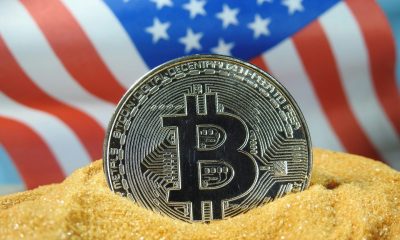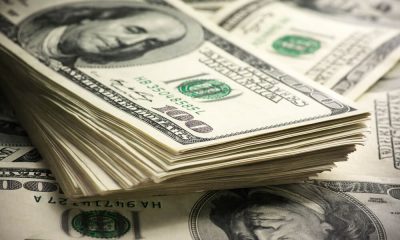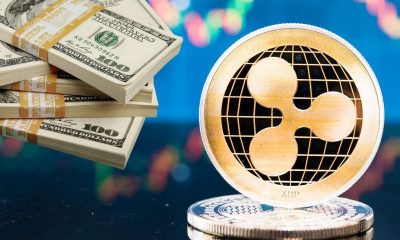

others
June’s US Consumer Price Index data key for Fed rate cut prospects – Crypto News
- The US Consumer Price Index is forecast to rise 3.1% YoY in June, at a softer pace than May’s 3.3% increase.
- Annual core CPI inflation is expected to hold steady at 3.4%.
- The inflation data could confirm or deny a Fed rate cut in September and drive the US Dollar valuation.
The Bureau of Labor Statistics (BLS) will publish the highly anticipated Consumer Price Index (CPI) inflation data from the United States (US) for June on Wednesday at 12:30 GMT.
The US Dollar (USD) braces for intense volatility, as any surprises from the US inflation report could significantly impact the market’s pricing of the Federal Reserve (Fed) interest rate cut expectations in September.
What to expect in the next CPI data report?
Inflation in the US, as measured by the CPI, is expected to increase at an annual rate of 3.1% in June, down from the 3.3% rise reported in May. The core CPI inflation, which excludes volatile food and energy prices, is seen holding steady at 3.4% in the same period.
Meanwhile, the US CPI is set to rise 0.1% MoM in June after staying unchanged in May. Finally, the monthly core CPI inflation is forecast to rise 0.2% to match the previous increase.
Federal Reserve (Fed) Chairman Jerome Powell delivered the Semi-Annual Monetary Policy Report and testified before US Congress earlier in the week. In his prepared remarks, Powell reiterated that it will not be appropriate to cut the policy rate until they gain greater confidence in inflation heading sustainably toward 2%. When asked about the latest developments in the jobs market, “the most recent labor market data sent a pretty clear signal that the labor market has cooled considerably,” he noted. In the end, his remarks failed to move the needle with respect to market pricing of a Fed rate cut in September. According to the CME FedWatch Tool, the probability of the Fed leaving the policy rate unchanged in September stands at around 26%, virtually unchanged from where it stood before this event.
Previewing the June inflation data, “we expect the June CPI report to show that core prices remained largely under control after posting a surprisingly soft 0.16% gain in May,” said TD Securities analysts in a weekly report.
“Headline inflation likely printed flat m/m again (-0.01%) as energy prices continue to provide large relief. Note that our unrounded core CPI forecast at 0.18% m/m suggests larger risks for another dovish surprise to a rounded 0.1% increase,” analysts added.
How could the US Consumer Price Index report affect EUR/USD?
Investors remain optimistic about a Fed rate cut in September, but the market positioning suggests they are not fully convinced yet. Hence, a smaller-than-forecast increase in the monthly core CPI, a reading of 0.1% or smaller, could confirm a policy pivot in September. In this scenario, the US Dollar could come under selling pressure with the immediate reaction.
On the other hand, an increase of 0.3% or bigger could highlight a lack of progress in disinflation and cause market participants to reassess the probability of an interest rate reduction in September. In this case, investors could price in a widening policy gap between the European Central Bank (ECB) and the Fed, opening the door for a sharp decline in EUR/USD in the near term.
Eren Sengezer, European Session Lead Analyst at FXStreet, offers a brief technical outlook for EUR/USD and explains: “EUR/USD holds above the 100-day and the 200-day Simple Moving Averages (SMA) following the pullback seen earlier in the week, reflecting sellers’ hesitancy. Additionally, the Relative Strength Index (RSI) indicator on the daily chart holds above 50 ahead of the US inflation data, indicating a slightly bullish bias in the short term.”
“The Fibonacci 23.6% retracement level of the mid-April-June uptrend forms interim resistance at 1.0850. Once EUR/USD clears this level, it could face next resistance at 1.0900-1.0915 (psychological level, June 4 high) before targeting 1.1000. On the downside, technical sellers could take action and force EUR/USD to stretch lower if the pair drops below 1.0800 (100-day SMA, 200-day SMA) and starts using this level as resistance. In this scenario, 1.0750 (20-day SMA) could be seen as the next support before 1.0680 (Fibonacci 78.6% retracement).”
US Dollar FAQs
The US Dollar (USD) is the official currency of the United States of America, and the ‘de facto’ currency of a significant number of other countries where it is found in circulation alongside local notes. It is the most heavily traded currency in the world, accounting for over 88% of all global foreign exchange turnover, or an average of $6.6 trillion in transactions per day, according to data from 2022. Following the second world war, the USD took over from the British Pound as the world’s reserve currency. For most of its history, the US Dollar was backed by Gold, until the Bretton Woods Agreement in 1971 when the Gold Standard went away.
The most important single factor impacting on the value of the US Dollar is monetary policy, which is shaped by the Federal Reserve (Fed). The Fed has two mandates: to achieve price stability (control inflation) and foster full employment. Its primary tool to achieve these two goals is by adjusting interest rates. When prices are rising too quickly and inflation is above the Fed’s 2% target, the Fed will raise rates, which helps the USD value. When inflation falls below 2% or the Unemployment Rate is too high, the Fed may lower interest rates, which weighs on the Greenback.
In extreme situations, the Federal Reserve can also print more Dollars and enact quantitative easing (QE). QE is the process by which the Fed substantially increases the flow of credit in a stuck financial system. It is a non-standard policy measure used when credit has dried up because banks will not lend to each other (out of the fear of counterparty default). It is a last resort when simply lowering interest rates is unlikely to achieve the necessary result. It was the Fed’s weapon of choice to combat the credit crunch that occurred during the Great Financial Crisis in 2008. It involves the Fed printing more Dollars and using them to buy US government bonds predominantly from financial institutions. QE usually leads to a weaker US Dollar.
Quantitative tightening (QT) is the reverse process whereby the Federal Reserve stops buying bonds from financial institutions and does not reinvest the principal from the bonds it holds maturing in new purchases. It is usually positive for the US Dollar.
Economic Indicator
Consumer Price Index (MoM)
Inflationary or deflationary tendencies are measured by periodically summing the prices of a basket of representative goods and services and presenting the data as The Consumer Price Index (CPI). CPI data is compiled on a monthly basis and released by the US Department of Labor Statistics. The MoM figure compares the prices of goods in the reference month to the previous month.The CPI is a key indicator to measure inflation and changes in purchasing trends. Generally, a high reading is seen as bullish for the US Dollar (USD), while a low reading is seen as bearish.
-

 De-fi1 week ago
De-fi1 week agoBinance Lists Dolomite’s DOLO Token, Adds Fifth Lira Pair – Crypto News
-
Technology1 week ago
XRP Ledger Secures Major Win, Powering China’s Top Supply Chain Firm – Crypto News
-

 De-fi1 week ago
De-fi1 week agoStablecoins Just Got Real: The Future of Programmable Money in the GENIUS Era – Crypto News
-

 Business5 days ago
Business5 days agoPYMNTS’ Summer of Big Quotes, From Tariffs to Trust Codes – Crypto News
-
others1 week ago
Ripple’s RLUSD Launches on Aave’s Horizon RWA Market as Adoption Expands – Crypto News
-
others1 week ago
Ripple’s RLUSD Launches on Aave’s Horizon RWA Market as Adoption Expands – Crypto News
-

 Technology1 week ago
Technology1 week agoMint Explainer | A web for machines, not humans: Decoding ex-Twitter CEO Parag Agrawal’s next big move – Crypto News
-

 Blockchain1 week ago
Blockchain1 week agoDecoding Google’s Layer-1 blockchain: what it means and what we know – Crypto News
-

 Cryptocurrency1 week ago
Cryptocurrency1 week agoPhilippine Senator Suggests Putting National Budget On-chain – Crypto News
-
Business1 week ago
Scott Bessent Says 11 ‘Strong’ Candidates in Line to Replace Fed Chair Powell – Crypto News
-

 Blockchain1 week ago
Blockchain1 week agoGoogle’s Rich Widmann shares LinkedIn update on Universal Ledger blockchain – Crypto News
-

 Cryptocurrency1 week ago
Cryptocurrency1 week agoSouth Korea Busts Hacking Syndicate After Multi-Million Dollar Crypto Losses – Crypto News
-

 De-fi1 week ago
De-fi1 week agoHYPE Hits New All-Time High as Hyperliquid Dominates DeFi Revenue – Crypto News
-
Technology1 week ago
Pump.fun Buys Back $58M PUMP Tokens; Price Up 4% – Crypto News
-
Business1 week ago
MetaPlanet Launches $881M International Stock Issuance for BTC Purchases – Crypto News
-

 Technology1 week ago
Technology1 week agoAave’s new Horizon allows institutions to borrow stablecoins using real-world assets – Crypto News
-

 Cryptocurrency1 week ago
Cryptocurrency1 week agoA Stable Investment Backed by Real-World Assets – Crypto News
-

 Cryptocurrency1 week ago
Cryptocurrency1 week agoSynthetix price soars 20% amid volume spike: here’s why – Crypto News
-

 Technology1 week ago
Technology1 week agoTrump Media teams with Crypto.com in $100M CRO token deal – Crypto News
-

 Blockchain1 week ago
Blockchain1 week agoFenwick Denies Lawsuit Claiming It Helped FTX Fraud – Crypto News
-

 Blockchain1 week ago
Blockchain1 week agoXRP Shows Strength Amid $3 Retest, But Price Risks Correction – Crypto News
-

 others1 week ago
others1 week agoDow Jones slows to a crawl amid quiet markets – Crypto News
-

 Technology1 week ago
Technology1 week agoPUMP circulating supply shrinks as Pump.fun’s total buybacks surpass $58M – Crypto News
-

 De-fi1 week ago
De-fi1 week agoSony’s Soneium Debuts Scoring System to Record Onchain Participation – Crypto News
-
others7 days ago
Japan CFTC JPY NC Net Positions rose from previous ¥77.6K to ¥84.5K – Crypto News
-
others3 days ago
CFTC Gives Crypto Prediction Platform Polymarket Greenlight To Launch In the U.S. – Crypto News
-

 Blockchain2 days ago
Blockchain2 days agoEtherealize Raises $40M to Market Ethereum to Finance Firms – Crypto News
-

 Cryptocurrency1 week ago
Cryptocurrency1 week agoLitecoin price forecast: what next as LTC drops to key support? – Crypto News
-
Business1 week ago
Ex-PBOC Chief Rejects China’s Stablecoin Push, Cites Financial Risks – Crypto News
-
Technology1 week ago
Pi Network Announces Major Protocol Upgrade as Valour Pi ETP Trading Begins – Crypto News
-

 Blockchain1 week ago
Blockchain1 week agoChainlink, Commerce Department Bring Data to Blockchain – Crypto News
-

 Cryptocurrency1 week ago
Cryptocurrency1 week agoThursday links: ATMs, dad logic and zombie tokens – Crypto News
-

 Blockchain1 week ago
Blockchain1 week agoAs US Data Moves to Blockchain, Should Businesses Follow? – Crypto News
-

 others2 days ago
others2 days agoXAG/USD bounces at $40.50, approaching $41.00 – Crypto News
-

 Technology1 week ago
Technology1 week agoJUP price rallies as Jupiter Lend public beta launches with $2M rewards – Crypto News
-

 De-fi1 week ago
De-fi1 week agoStablecoin Platform M0 Raises $40 Million in Polychain-Led Series B – Crypto News
-

 Cryptocurrency1 week ago
Cryptocurrency1 week agoXYZVerse (XYZ) at $0.0054 Chosen Over Solana and Cardano for $10 This Bull Run Target – Crypto News
-

 Cryptocurrency7 days ago
Cryptocurrency7 days agoUS and Dutch Authorities Take Down Crypto-Fueled Fake ID Marketplace – Crypto News
-

 Cryptocurrency2 days ago
Cryptocurrency2 days agoHistoric Bitcoin-S&P decoupling fuels altseason hopes – All the details! – Crypto News
-

 Cryptocurrency2 days ago
Cryptocurrency2 days agoReverse-takeover DATs are a grab bag of risks for investors – Crypto News
-

 Cryptocurrency2 days ago
Cryptocurrency2 days agoRipple (XRP) Slips 5% Weekly But Analysts See Potential for a New ATH – Crypto News
-

 Blockchain1 week ago
Blockchain1 week agoXRP Historical Performance Points To 200% Rally To $9.63 – Crypto News
-

 Technology1 week ago
Technology1 week agoHere’s how Apple’s iOS 26 might severely impact Republicans ahead of midterms – Crypto News
-

 De-fi1 week ago
De-fi1 week agoGoogle Cloud Unveils Universal Ledger Blockchain for Institutional Payments, CME Pilot – Crypto News
-
Technology1 week ago
Lisa Cook Sues Trump as Fed Drama Intensifies Ahead of Crucial September FOMC – Crypto News
-

 others1 week ago
others1 week agoUS Dollar Index drops to near 98.00 amid caution ahead of US PCE inflation data – Crypto News
-

 De-fi1 week ago
De-fi1 week agoSolana Leads Major Altcoins as Buyers Pile In Ahead of Treasury Companies – Crypto News
-

 Metaverse1 week ago
Metaverse1 week agoAI Travel Assistance: Can AI assistants really plan a perfect vacation for you? Here’s the truth – Crypto News
-
Cryptocurrency1 week ago
Strategy Investors Drop Class Action Over Bitcoin Accounting Misrepresentation – Crypto News
-

 Technology1 week ago
Technology1 week agoAI can’t match human creativity, says Fields medalist Manjul Bhargava – Crypto News






